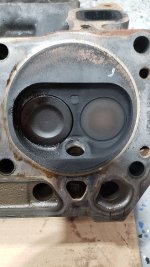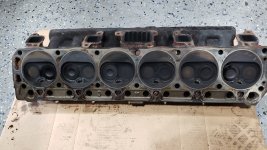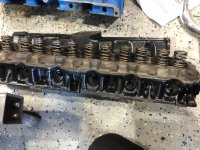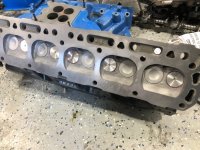You are using an out of date browser. It may not display this or other websites correctly.
You should upgrade or use an alternative browser.
You should upgrade or use an alternative browser.
All Small Six '62 Falcon 200: Overheating Diagnosis & Build Options
This relates to all small sixes
I asked a few the 63/64 falcon owners at two local car shows, as I was having minor coolant issues over the summer with my Fairmont. the three I spoke with stated they had to do two things to keep engine temps at reliable levels: a fan shroud was stated as the largest improvement, and replacing the hood/radiator mount rubber filler. without the filler strip across the radiator mount, too much air is allowed through the gap between the top of the radiator and hood. by making sure the hood rubber is in place, and a fan shroud, a lot more air is forced to go through the radiator and coolant temps should be in a much more reasonable area. both are things I also had to do to my Fairmont; however, my radiator is a single-core variety.
When you install the new rad, fill it with straight water. Water will cool better. If all is good then back to your normal anti freeze mix. If your in SoCal then
a lower mix will help cooling
Just some basic numbers...
15 lb cap plain water will boil at about 246 degrees
15 lb cap and 33% antifreeze will boil at about 256 degrees
1) your numbers are in the ballpark, however are misleading.
2) I really hope you mean distilled water.
Whereas water boils at around 212°F. at atmospheric pressure, if exposed to 15 psi (a common radiator pressure cap), the boiling point will now be 45°F. higher (3 psi times 15 psi cap). Under this pressure, water boils at 257°F.
At sea level, water boils at 212 °F. With each 500-feet increase in elevation, the boiling point of water is lowered by just under 1 °F. At 7,500 feet, for example, water boils at about 198 °F. In SoCal elevations range from 500 ft to 11,500 ft (150 m to 3,500 m)
A coolant mixture of 50% water and 50% ethylene glycol has a boiling point of 223 °F. A system with 15 psi cap will add 45 degrees for a final boiling point of 268 °F. The real purpose of pressurizing is to give drivers a higher operating zone in case of extreme conditions.
Then figuring in the elevation changes of SoCal; you are looking at between 245 °F to 268 °F for the boiling point with a 50/50 blend and between 234 °F to 257 °F for plain water. with an 11°F higher boiling point, my personal conclusion would be a 50/50 blend would inharently cool better, and would have a less unstable fluid level; as more fluid staying in the system means more thermal entropy is taking place, and thus cooling better.
Even with your own numbers, the higher boiling point means that 'straight water' does not cool better when figuring in thermodynamics. the absolute highest boiling temp (16 psi cap, at sea level) you can expect from a 33% Ethylene Glycol blend is 260°F so its the same as running distilled water, you aren't getting any of the thermodynamic behavior the fluid is designed for at that low of a mixture.
Last edited:
I use a 16lb cap on my radiator; as that's what my 1982's 200 needed; which would push my numbers up another 3 degrees. so a 50/50 boiling point with my cap in SoCal would 248-271; and distilled water to 237-260.
so a bit more operating temp; and 50/50 has a lower freezing point than distilled water as well, but SoCal rarely has to worry about the reasons my engine has the factory-installed optional block heater. (it gets cold where that car was bought new). my elevations are different here, but its still in a decent ballpark.
here is an AU report on why antifreeze is important, and alot of the wonderful things proper blends, and those pesky 2-3 year coolant changes, can do for your engine. https://practicalmotoring.com.au/car-advice/what-is-coolant-antifreeze-and-why-does-you-car-need-it/
so a bit more operating temp; and 50/50 has a lower freezing point than distilled water as well, but SoCal rarely has to worry about the reasons my engine has the factory-installed optional block heater. (it gets cold where that car was bought new). my elevations are different here, but its still in a decent ballpark.
here is an AU report on why antifreeze is important, and alot of the wonderful things proper blends, and those pesky 2-3 year coolant changes, can do for your engine. https://practicalmotoring.com.au/car-advice/what-is-coolant-antifreeze-and-why-does-you-car-need-it/
Last edited:
1) your numbers are in the ballpark, however are misleading.
2) I really hope you mean distilled water.
Whereas water boils at around 212°F. at atmospheric pressure, if exposed to 15 psi (a common radiator pressure cap), the boiling point will now be 45°F. higher (3 psi times 15 psi cap). Under this pressure, water boils at 257°F.
Ok I needed to check my math, to much/not enough coffee. This was a short term test so just tap water was fine. If the test was negitive, I told the owner to go back to a location specific anti-freeze mix.
But that water will transfer more btu per unit of time than 50/50 anti-freeze is a fact! Transfer effecency for water is around .6 and 50/50 anti freeze is around .25. However if the water boils then all bets are off. Steam is a lousy conductor. The coolant mix raises the boiling point and allows the engine to safely run hotter. A side effect is the hotter the engine can safely run, the higher the Delta (coolent temp vs air temp) in the cooling system is. That makes the radiator more efficent. A side, side effect that the bean counters and designers, love the more efficent the radiator is, the smaller it can be, smaller means cheaper and for the designers it means better streamlining.
So after the head was pulled it looks like we had at least some warping with some less than serious carbon buildup, but still a contributing factor attributed to some leaky valve seals. Hopefully this was the culprit for the heat, the new head is being installed with all new brackets for the pulleys (a/c and alternator). Will update further once the top end is back together with the newly rebuilt top end (large log 200 head all new exhaust valves and adjustable rockers)
Attachments
Congrats head dosen't look to bad, maybe a little bit of rust built up in some of the cooling passages and the valve seem to be standing up good to with not to much recession. How do the cooling passages look inside the block and the old head gasket?
Coolant passages were pretty clean because of how many times we flushed the block. The head gasket was intact but was pretty rusty.Congrats head dosen't look to bad, maybe a little bit of rust built up in some of the cooling passages and the valves seem to be standing up good yet with not to much recession. How do the cooling passages look inside of the block and the old head gasket?
The bottom 2 photos are the new head. All new Gaskets will go in.
Rinke
Well-known member
Yes. Actually about a year ago i noticed my pump leaking. I had a replacement on the shelf. When I swapped the pump there was a large part missing on one of the old pump impellers. I also switched to a 180 deg t stat as per shop manual and the car runs way cooler. I only use premixed g12 or higher g nummer coolant as was advised by the rad shop.have others experienced a water pump with a rotted away impaler? I have never seen this happen but maybe in hard water areas ? Myself, ive seen a few fail at the seals, usually what Ive seen is they leak quite sudddenly and seriously and at a bad time, but never a bad impaller. I changed mine for reliabity but I dont think it caused any of my my overheating issues.
Grtz Rinke
Rinke, LOL that reminds me of a seemular time back in 1977, i also had that happen not to long after I gotten my low Milage 1977 Maverick 250 and was putting it back into running condition. I bought a rebuilt water pump for it and installed it then the trouble started not to long after. I could drive around town or up to about 55 MPH any faster it would start pushing the coolant out of the Radator and then it would overheat, I checked almost everything except for that water pump after all that was only a few months old at that time and it showed no signs of leaking externally, still I couldn't find anything else wrong. Finally I decided to pull that water pump back off and there was the cause of all this trouble the impeller was compleatly gone just the shaft was left turning in the pump housing. That was the last rebuilt water pump I used and went with only the new water pumps after that, because of that rebuilt pump cost me a lot of extra time and money in the damage it caused.Yes. Actually about a year ago i noticed my pump leaking. I had a replacement on the shelf. When I swapped the pump there was a large part missing on one of the old pump impellers. I also switched to a 180 deg t stat as per shop manual and the car runs way cooler. I only use premixed g12 or higher g nummer coolant as was advised by the rad shop.
Grtz Rinke
Hi Clwoods, that new head looks great, will be looking forward to hearing how well it works! Did you measure how far the piston top is from the block deck, and the CC's of the old head? Are you still considering the C4 Trans swap? Best of luckCoolant passages were pretty clean because of how many times we flushed the block. The head gasket was intact but was pretty rusty.
The bottom 2 photos are the new head. All new Gaskets will go in.
5 pages, over 80 posts, again...think this is a build thread nota simple Q. More on the ask of "Where to go on a rebuild search." A local is nationally known:
Arthur Gould
only contact: 508-210-0891
or letter
789 Wachusett St
Holden, MA 01520
Water (& fuel) pump rebuilding
Arthur Gould
Arthur Gould Rebuilders | Water Pump & Fuel Pump Rebuilders
Arthur Gould Rebuilders, auto and marine water pump and fuel pump rebuilding.
vintageautopumps.com
or letter
789 Wachusett St
Holden, MA 01520
Water (& fuel) pump rebuilding
I'm late to this party, but I'll add my bit:
Wayer pump. Just because it's new and a brand name doesn't mean it's working properly. I've noted a lot more new parts failing (and poor 'Quality Control") in the last couple years, even from major names. (Uncle Tony's Garage on YouTube for more examples).
Impellers can disintegrate, or more commonly just slip on the shaft once warmed up.
Wayer pump. Just because it's new and a brand name doesn't mean it's working properly. I've noted a lot more new parts failing (and poor 'Quality Control") in the last couple years, even from major names. (Uncle Tony's Garage on YouTube for more examples).
Impellers can disintegrate, or more commonly just slip on the shaft once warmed up.
The Flow Kooler water pump is not just a "high flow" pump its impeller is designed off of modern pumps that actually move more volume not just force the water through faster, coupled with it being machined out of billit, the pump is solid... I appreciate the input, especially as we are nearing all of the "reassembly check lists" always good to have a few reminders!I'm late to this party, but I'll add my bit:
Wayer pump. Just because it's new and a brand name doesn't mean it's working properly. I've noted a lot more new parts failing (and poor 'Quality Control") in the last couple years, even from major names. (Uncle Tony's Garage on YouTube for more examples).
Impellers can disintegrate, or more commonly just slip on the shaft once warmed up.
Similar threads
- Replies
- 26
- Views
- 11K
- Replies
- 18
- Views
- 3K





